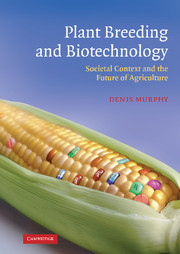Book contents
- Frontmatter
- Contents
- Preface
- Acknowledgements
- Using this book
- Nomenclature and terminology
- Abbreviations and glossary
- Introduction
- Part I The science of plant breeding
- Part II The societal context of plant breeding
- Part III Turmoil and transition: the legacy of the 1980s
- 7 Resurgence of the private sector
- 8 Emergence of a new crop improvement paradigm
- 9 Decline of the public sector
- 10 Reaping the consequences
- Part IV The agbiotech paradigm
- Part V Increasing global crop production: the new challenges
- Part VI Plant breeding in the twenty-first century
- Notes
- References
- Index
7 - Resurgence of the private sector
Published online by Cambridge University Press: 07 May 2010
- Frontmatter
- Contents
- Preface
- Acknowledgements
- Using this book
- Nomenclature and terminology
- Abbreviations and glossary
- Introduction
- Part I The science of plant breeding
- Part II The societal context of plant breeding
- Part III Turmoil and transition: the legacy of the 1980s
- 7 Resurgence of the private sector
- 8 Emergence of a new crop improvement paradigm
- 9 Decline of the public sector
- 10 Reaping the consequences
- Part IV The agbiotech paradigm
- Part V Increasing global crop production: the new challenges
- Part VI Plant breeding in the twenty-first century
- Notes
- References
- Index
Summary
Government has laid its hand on health, housing, farming, industry, commerce, education … But the truth is that outside of its legitimate function, government does nothing as well or as economically as the private sector of the economy. What better example do we have of this than government's involvement in the farm economy over the last thirty years. One-fourth of farming has seen a steady decline in the per capita consumption of everything it produces. That one-fourth is regulated and subsidized by government. In contrast, the three-fourths of farming unregulated and unsubsidized has seen a 21% increase in the per capita consumption of all its produce.
Ronald Reagan (1911–2004) Campaign speech, 27 October 1964Introduction
By the 1970s, the public sector was the overwhelmingly dominant force in plant science research and crop breeding throughout the world. In countries like the USA, there had been over a century of such a tradition, and most other industrialised countries had also witnessed many decades of public sector led agricultural improvement. The public sector model was also being embraced with enthusiasm by most developing countries, and the newly established CGIAR network was steadily extending the public-good improvement paradigm across the world. So why is it that, especially since the mid-1980s, we have witnessed such a strong resurgence of private sector involvement in crop improvement? Why is it that the private sector agenda, and especially the agbiotech paradigm, seems to dominate so much of today's plant breeding research and development (R&D)?
- Type
- Chapter
- Information
- Plant Breeding and BiotechnologySocietal Context and the Future of Agriculture, pp. 101 - 114Publisher: Cambridge University PressPrint publication year: 2007



